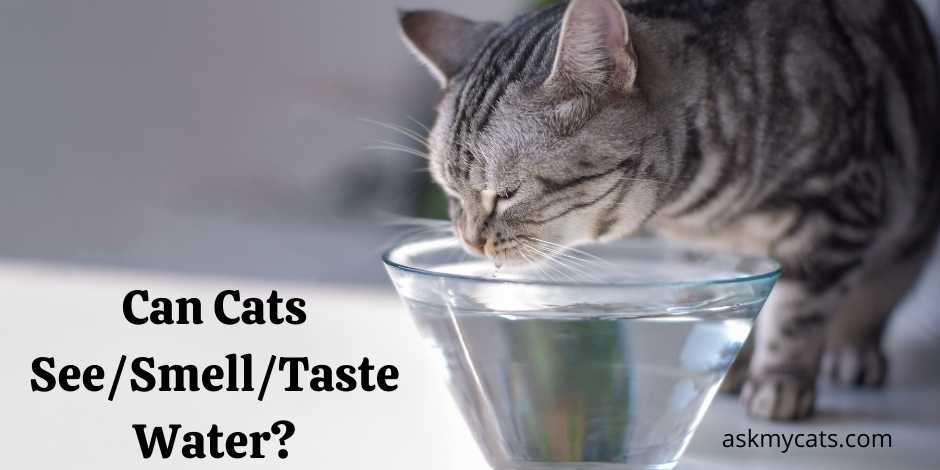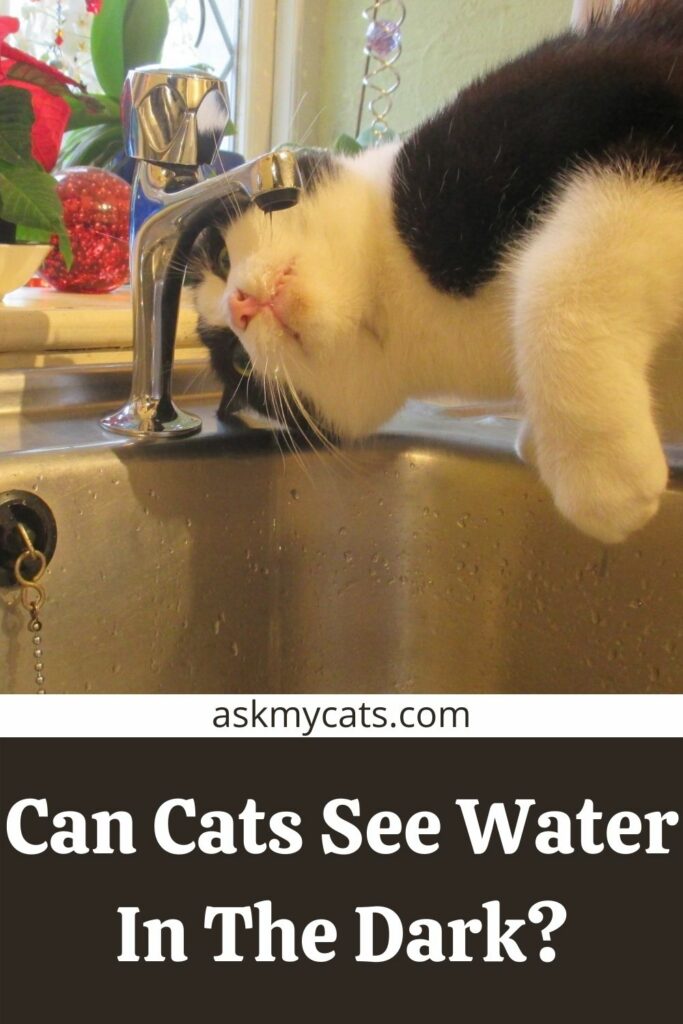Cat senses are a set of traits that enable cats to be extremely effective predators. Cats have excellent vision in low light, a keen sense of hearing and smell, and long whiskers that extend from their heads and bodies increase their sense of touch. These senses evolved to allow cats to hunt at dawn and night successfully.
Cats are able to smell and taste water due to their enhanced sensing abilities but they are unable to see still water.
Keep reading this article to know more about this!


Give Your Cat the Perfect Day
Get the Free Ebook!
Can Cats See Water?
Cats’ close-up eyesight is significantly poorer than their long-distance vision, thus they can’t see the water level when they’re very next to their water bowl.
Cats, on the other hand, are known for being quite picky. Some cats will refuse to drink from a water bowl if it is close to their food bowl. Others want a water feature, such as a fountain or even the kitchen sink.
Some cats refuse to drink from plastic or metal containers. Some of their tastes may be traced back to their forefathers’ survival instincts.
Cats have hard time getting water because they can’t see still water very well, and they may feel uncomfortable sitting at a dish, especially if it’s in a corner with their back to other cats that could leap on them.
Since moving water is usually cleaner and tastes better than still water, cats like to drink from it. Because water flowing down a drain is moving water, your cat is enthralled by it.
That is why some cat owners purchase a water fountain for their pets. Cats, like a previous response, are aware of movement.
Can Cats See Water In The Dark?
No, cats cannot see water in the dark.

The quick answer is that it isn’t quite right. Whereas it is commonly believed that cats have their own built-in set of night vision goggles, they really require some light to see.
They, on the other hand, require only one-sixth of the amount of light that humans do and can see in extremely dim light.
In the rare occasion when all light is shut off; cats will be unable to see water in the dark but feline vision is far superior to that of humans for all of their night-time activities.
The sophisticated architecture of cats’ eyes is the explanation for their superb night vision. They have a curved cornea and a big lens, and their pupils may dilate to complete circles in low light to let in as much light as possible.
In addition, the photoreceptors in cats’ eyes are not the same as those in humans. Humans have more cones than cats, which allow them to see colours and lights better. Cats have more rods, which are responsible for night vision, peripheral vision, and motion detection.
Cats’ eyes have a large number of rods, which allows them to see better in dim light but not as well as humans in bright light.
A cat’s tapetum, which is a reflecting layer of tissue that reflects light back to the retina, is also present. This layer of reflecting tissue reflects light back to the sensory cells, allowing the retina to receive almost half of the available light. When you take a shot of your cat with a flash or see their eyes reflected by headlights, the tapetum is partly to blame.
While cats’ night vision is unquestionably superior to ours, they are also nearsighted and have difficulty focusing on distant things. Humans can be up to 5 times farther away than a cat to see anything in the same level of detail.
Although cats’ eyesight is far blurrier than humans’, they have a broader range of vision of 200 degrees (compared to 180 degrees for humans) for superior peripheral vision. They’re also better at detecting little movements and changes in light, such as a scurrying mouse’s shadow.
Can Cats See Still Water?
No, cats can’t see still water due to their poor near vision.
If your cat likes to dip their paw in the water dish before drinking or bump the dish and make water spill everywhere, it’s possible that they aren’t attempting to annoy you. Moving water is really preferred by cats over static water.
They developed in the environment to know that still water is frequently stagnant and, as a result, might contain harmful germs that will make them sick.
If your cat doesn’t appear to be getting enough water, consider purchasing a cat water fountain from your local pet store. They could begin to drink a lot more!
Some cats like to keep their water dishes separate from their food bowls. Add a second water bowl in a separate room if you don’t think your cat is drinking enough.
Can Cats See Water In A Bowl?
Cats cannot see the level of water in a bowl.

Cats have a blind spot immediately in front of their snout, indicating that they have poor depth perception. As a result, they may struggle to perceive where the water in the bowl begins, resulting in a snoot full of water. This is why some cats will test the water level by dipping a paw in it.
It’s possible that your cat likes to drink from a running faucet since they can hear the rushing water better than the still water in the dish.
Some picky cats will only drink from the water bowl if it is the “perfect” bowl for them. It’s up to you to figure out what the ideal dish is for your cat, and you might have to experiment with a few various kinds to determine which they like.
Most cats prefer dishes that are broad enough to accommodate their delicate whiskers; a bowl that is too deep or narrow may squash or irritate their whiskers, making drinking uncomfortable.
The food and water dishes of most cats are naturally placed adjacent to each other. However, a cat’s natural tendency to keep food and water separate may be harmed by this positioning.
In the wild, cats will go to considerable lengths to keep their food and water sources separate in order to prevent contaminating the water with the food.
If you find that your cat’s water bowl is too close to the food and the fresh water dish is continually getting dried kibbles, just move the water dish. It really can be that easy!
How can I Help My Cat See Water?
You cannot help your cat to see water. But you can guide your cat how to drink water from the bowl.
The water bowl for your cat should be 3-5 feet distant from its eating bowl. Many cats are sensitive to the smell of food near their drinking source.
Mixing food and water in the wild frequently leads in bacterial development and sickness. Cats may also choose to drink and eat in various locations in order to avoid predators.
Can Cats Smell Water?
Cats can smell the chemicals in the water.
A cat’s most dependable sense is the smell. The chemicals in tap water give it a distinct odour that a kitten’s keen nose will recognise right away, even if humans don’t notice them.
It’s acceptable to dip a paw in now and again, but submerging their fur in a liquid that smells nothing like their coat should smell is enough to put them off bath time.
Chemicals are commonly used to treat tap water, and it is frequently chlorinated to the point where a cat can detect it. Cats’ noses are significantly more sensitive than humans, and many cats find this chemical odour revolting. In the eyes of a cat, stale water in puddles and pools has a considerably more appealing odour.
Can Cats Taste Water?
Cats are sensitive to the taste and presentation of water.

Water is not tasteless to cats, according to electrophysiological recordings. Also, unlike other animals, cats appear to be uninterested in sucrose, but this might be due to the flavour of the water in which it is dissolved masking the taste of the sucrose.
Water has a distinct flavour for cats. Water receptors are found in all carnivores, including humans, and aid in swallowing. Cats, on the other hand, have taste receptors for water.
This implies that, whereas we may find water insipid and boring without a little taste, cats find it delicious.
Water becomes sweeter for cats after they consume meat, which helps them drink enough water to counteract the salty of the meat.
Frequently Asked Questions
How Do Cats Know Where Water Is?
They will move the dish to cause the water to ripple and splash in order to see where the water begins – or whether there is any water in the dish at all.
How do cats find water outside?
Cats evolved as desert animals, so they don’t require much and get most of their moisture from their diet. They do, however, require freshwater, which they will seek out in streams, puddles, bird baths, leaking hoses, and drain pipes, among other places.
Why do cats touch the water before drinking?
They have more nerve endings and are more deeply rooted than typical hairs. When the cat lowers her head for a drink, the whiskers might get squished if the water bowl is too tiny or deep. A cat may learn that it’s better to merely dip a paw in the water to escape this discomfort.
Final Words
A cat is able to sense, smell and taste water but due to its poor near vision, they are unable to see still water in their bowls.
The chemicals in the water can be detected by cats. Even if humans can’t smell them, the chemicals in tap water give it a distinct odour that a kitten’s keen nose can identify right away.
Ask us in the comments section below.
